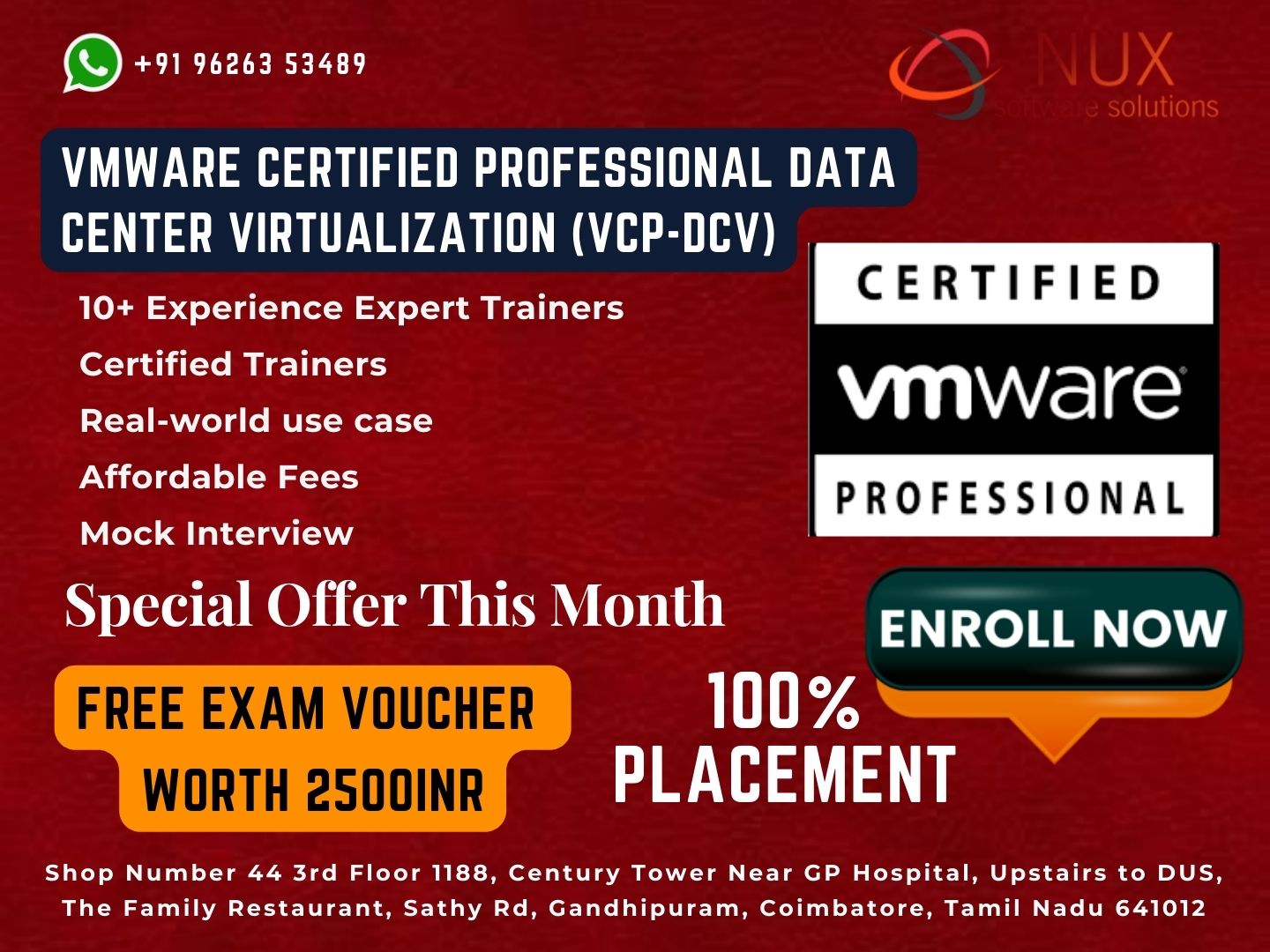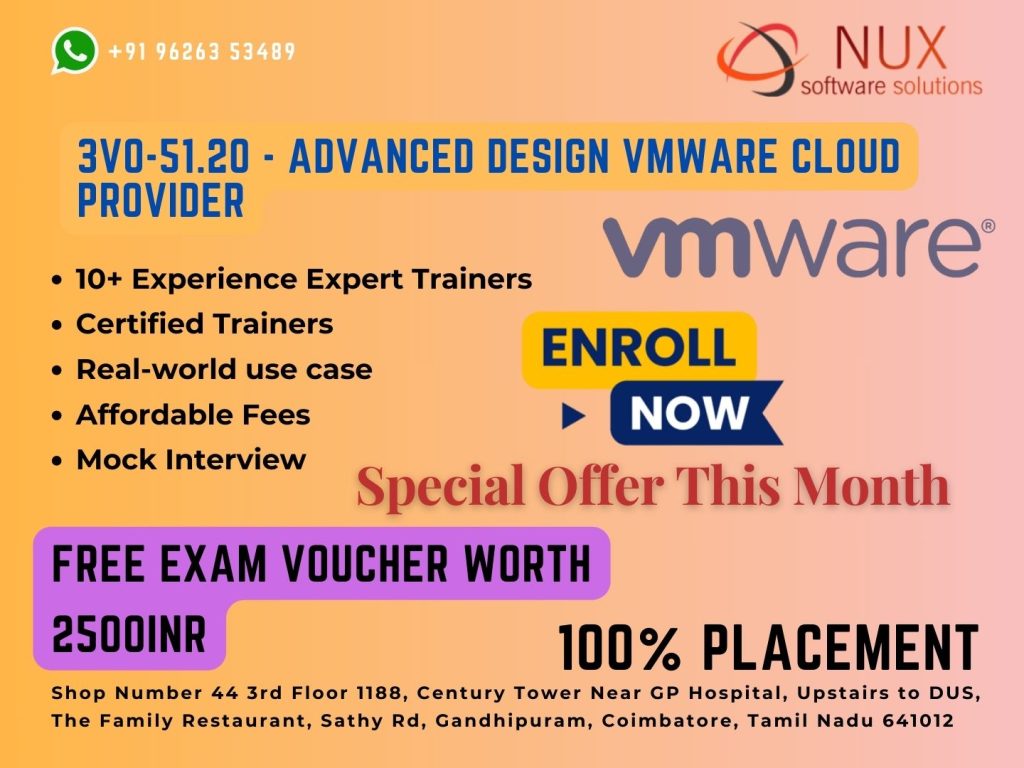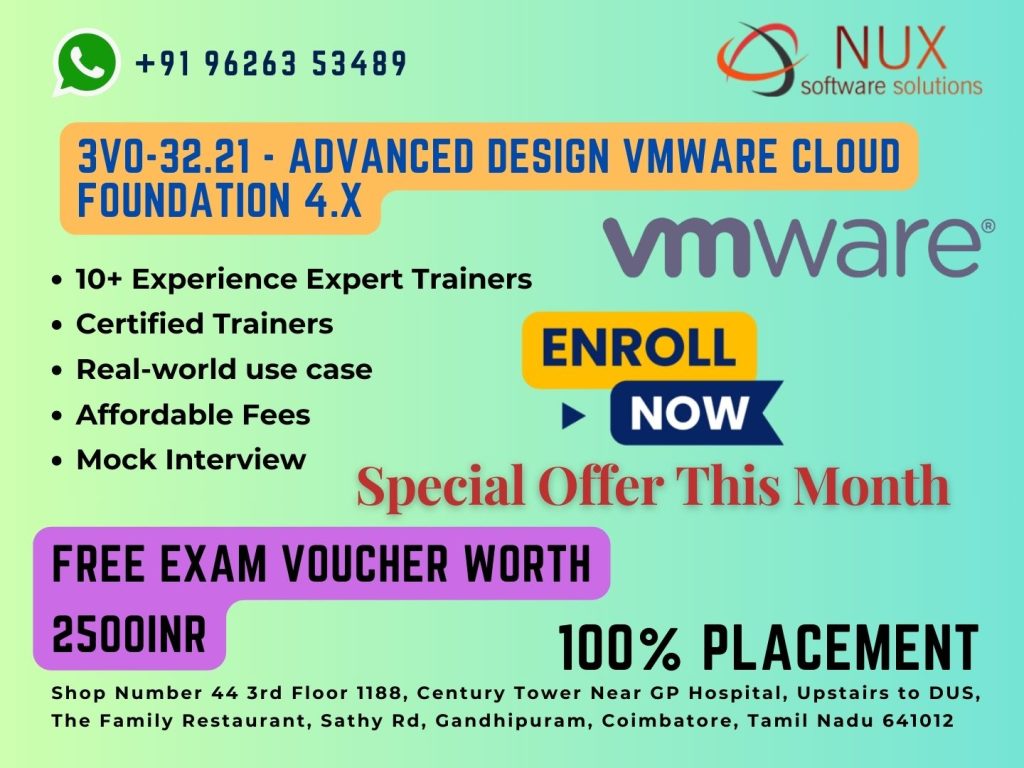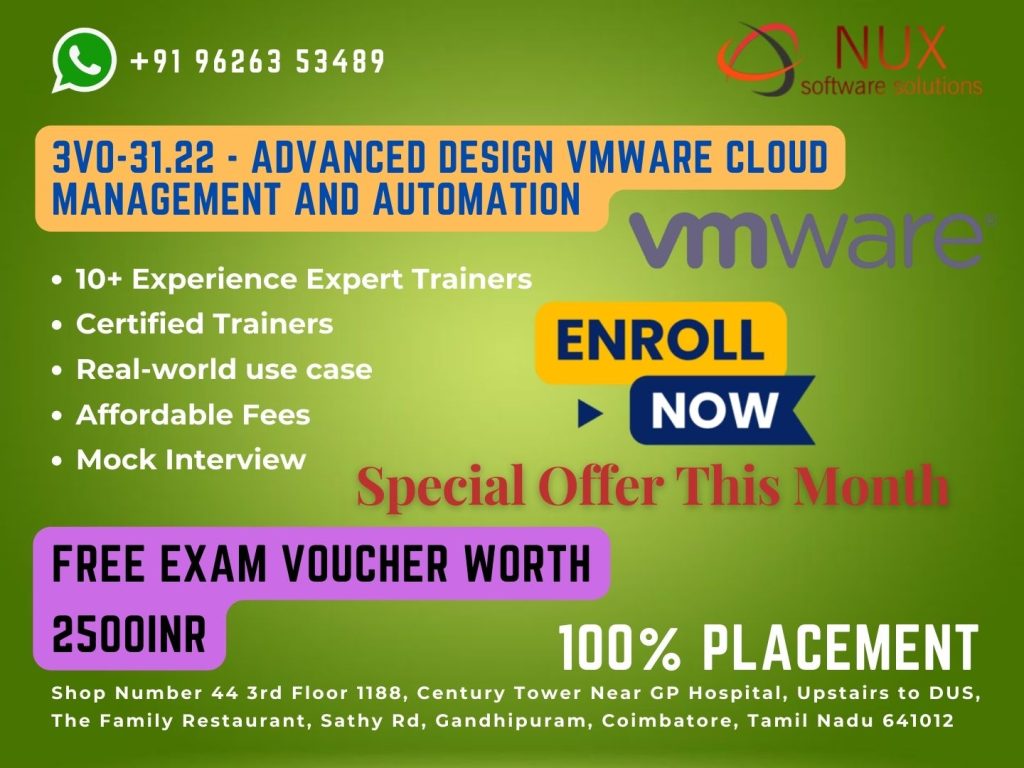VMware Associate Data Center Virtualization (VCA6-DCV)

Course Overview
The VCA6-DCV (VMware Certified Associate – Data Center Virtualization) certification training is designed to provide aspiring IT professionals with a clear understanding of virtualized data centers using VMware vSphere technologies. This course focuses on how virtualization enables IT resource consolidation, agility, and cost efficiency.
Ideal for beginners or non-technical roles transitioning into IT, the training introduces concepts such as virtual machines, ESXi, vCenter Server, and the core benefits of VMware’s virtualization solutions in modern data centers. It also prepares candidates for the VCA6-DCV certification exam, which validates entry-level knowledge in data center virtualization.
Why Choose This Course
Gain a solid foundation in VMware vSphere and virtual infrastructure
Understand how virtualization impacts compute, storage, and network resources
Learn the core business benefits of data center virtualization
Ideal starting point for advanced certifications like VCP-DCV
Recognized by employers as an entry-level certification in VMware ecosystem
Who Should Enroll
Entry-level IT professionals and system support staff
College students or graduates exploring virtualization careers
IT sales or pre-sales professionals supporting VMware-based solutions
Network and server administrators looking to understand virtual data centers
Candidates preparing for the VCA6-DCV certification
Skills You Will Gain
Understanding the role and value of VMware vSphere in data centers
Learning key components: ESXi, vCenter Server, virtual machines (VMs)
Identifying use cases for vMotion, HA (High Availability), and DRS
Exploring the impact of virtualization on storage and networking
Describing basic administration tasks and infrastructure scalability
Navigating VMware’s ecosystem, architecture, and management tools
Career Opportunities
Associate VMware Administrator
Virtual Infrastructure Support Technician
Junior Data Center Technician
IT Support – Virtualization Path
Technical Sales/Pre-sales Specialist (VMware solutions)
This certification is ideal for roles in organizations adopting virtualized environments, especially across IT services, managed hosting, education, and enterprise infrastructure support.
Step Into the World of Virtualization with VMware
The VCA6-DCV certification sets the foundation for a successful career in virtual infrastructure and data center management. Start your journey toward advanced VMware expertise today.
Enroll in VCA6-DCV Training at Linux Training Center, Coimbatore
VMware VCA6-DCV Syllabus
Modules
Section 1: Explain Data Center Virtualization Concepts and Identify Typical Data Center Challenges
Identify and Explain the Concept of Data Center Virtualization
knowledge
- Explain Data Center Virtualization.
- Differentiate Physical and Virtual Data Center Components.
- Identify Data Center Virtualization Benefits.
Tools:
- Virtualization Basics
- VMware vSphere 6.0 Overview
- The Business Value of Virtualization
- Business and Financial Benefits of Virtualization
Identify Challenges that can be resolved with VMware vSphere with Operations Management
knowledge:
- Identify VMware vSphere Editions.
- Identify common management challenges.
- Identify common scalability challenges.
- Identify common optimization challenges.
Tools:
- Compare vSphere Editions
- VMware vSphere Essentials Kit and Essentials Plus Kit Datasheet
- The Business Value of Virtualization
- Business and Financial Benefits of Virtualization
Section 2: Identify, Explain and Differentiate VMware vSphere Technologies
Describe how the components of VMware vSphere support Data Center Virtualization
knowledge:
- Explain the concept and capabilities of virtual machines and vApps.
- Explain the concept and capabilities of a virtual machine.
- Identify purpose of ESXi and vCenter Server.
- Differentiate VMware migration technologies.
- Differentiate VMware availability technologies.
- Explain the concepts of clusters and resource pools.
- Identify and explain common VMware data center products.
Tools:
- Virtualization Basics
- VMware vSphere 6.0 Datasheet
- Explore vSphere Availability Features
- Explore vSphere Migration Features
- Explore Resource Management Features
- vSphere Web Client
Differentiate VMware vSphere Storage Technologies
knowledge:
- Differentiate physical and virtual storage.
- Explain the use of shared storage in a vSphere implementation.
- Differentiate VMFS and NFS datastores.
- Differentiate virtual disk provisioning methods.
- Explain Virtual SAN capabilities.
- Explain Virtual Volume capabilities.
- Identify capabilities of Storage I/O Control.
- Identify capabilities of Storage DRS.
- Explain VMware virtual storage technologies.
Tools:
- What’s New in in the VMware vSphere 6.0 Platform
- Explore vSphere Storage Features
- What’s New: VMware Virtual SAN 6.0
- What’s New: VMware vSphere Virtual Volumes
- Explore Storage I/O Control (SIOC) Features
- vSphere Web Client
Differentiate VMware vSphere Networking Technologies
>Knowledge:
- Differentiate physical and virtual networking.
- Differentiate VMware virtual switch technologies.
- Identify VMware virtual switch components.
- Identify common virtual switch policies.
- Identify capabilities of Network I/O Control.
- Differentiate traffic control mechanisms.
Tools
- What’s New in in the VMware vSphere 6.0 Platform
- Explore vSphere Networking Features
- Network I/O Control (NIOC) Feature Summary
- vSphere Web Client
Differentiate VMware vSphere Resource Management Technologies
knowledge:
- Differentiate vSphere resource management features.
- Remediate resource management challenges.
- Identify all vMotion technologies (Storage, Resource, Long distance, etc.).
- Explain Distributed Resource Management, Distributed Power Management and High Availability.
Tools:
- What’s New in in the VMware vSphere 6.0 Platform
- Explore Resource Management Features
- Explore vSphere Migration Features
- vSphere Web Client
Differentiate VMware vSphere Availability Technologies
Knowledge:
- Differentiate vSphere high availability features.
- Remediate high availability challenges.
- Identify vSphere Disaster Recovery solutions.
- Differentiate VMware disaster recovery/disaster tolerance technologies.
- Explain vSphere Fault Tolerance.
- Identify vSphere Replication requirements.
Tools:
- Introduction to VMware vSphere Data Protection
- Introduction to vSphere Replication
- Explore vSphere Availability Features
- Introduction to Data Protection
- vSphere Web Client
Differentiate VMware Data Center Virtualization Products
Knowledge:
- Explain features of VMware NSX.
- Explain features of vRealize Operations.
- Explain features of vRealize Automation.
- Explain features of Site Recovery Manager.
Tools:
- What’s New in in the VMware vSphere 6.0 Platform
- VMware NSX Datasheet
- NSX Feature Walk Through
- vRealize Operations Datasheet
- vRealize Operations Feature Walk Through
- vRealize Automation Datasheet
- vRealize Automation Feature Walk Through
- VMware vRealize Air Homepage
- VMware vRealize Suite Datasheet
- vSphere Web Client
Section 3: Perform Operational Tasks using the vSphere Web Client
Identify and Understand Virtual Infrastructure Object Status
Knowledge:
- Identify different virtual infrastructure objects within the vSphere Web Client.
- Differentiate visual status indicators for various object states and conditions.
- Describe actions that can be taken on objects given a specific state of condition.
Tools:
- Using the vSphere Web Client
- vCenter Server and Host Management
- vSphere Virtual Machine Administration
- vSphere Web Client
Understand Hierarchy and Inventory Objects within the vSphere Web Client
Knowledge:
- Differentiate the functions of the vSphere Web Client panes.
- Describe vSphere Web Client Navigation, Filter and Search options.
- Describe the Access Control system.
- Understand how roles and/or permissions are assigned.
- Understand virtual machine file and inventory structure and mechanisms.
- Understand the benefit of tags assigned to inventory objects.
Tools:
- Using the vSphere Web Client
- vCenter Server and Host Management
- vSphere Virtual Machine Administration
- vSphere Permissions and User Management Tasks
- vSphere Web Client
Monitor Virtual Machine and ESXi Host Status
Knowledge:
- Install the Client Integration Plug-in.
- Install the VMware Remote Console.
- Install and/or Upgrade VMware Tools.
- Understand and differentiate virtual machine performance charts.
- Monitor Virtual Machine CPU/Memory/Disk utilization.
- Monitor ESXi Host health status.
- Monitor ESXi Host and virtual machine tasks.
- Monitor ESXi Host and virtual machine events.
- Monitor ESXi Host and virtual machine alarms.
Tools:
- Using the vSphere Web Client
- vCenter Server and Host Management
- vSphere Virtual Machine Administration
- vSphere Monitoring and Performance
- vSphere Web Client
Perform Virtual Machine Operations
Knowledge:
- Differentiate the power states of a virtual machine.
- Configure startup options for virtual machines running on a host.
- Manage the power operations of a virtual machine.
- Manage the power operations of a vApp.
- Install a guest OS to an existing virtual machine.
- Manage removable media.
Tools:
- Using the vSphere Web Client
- vCenter Server and Host Management
- vSphere Virtual Machine Administration
- vSphere Web Client
Section 4: Correlate VMware Virtualization Solutions with Common Data Center Business Challenges
Perform Virtual Machine Operations
Knowledge:
- Apply VMware virtualization technologies to resolve common data center availability challenges.
- Apply VMware virtualization technologies to resolve common data center management challenges.
- Apply VMware virtualization technologies to resolve common data center optimization challenges.
- Apply VMware virtualization technologies to resolve common data center scalability challenges.
- Differentiate SMB and Enterprise data center challenges and solutions that can be met with vSphere.
Tools:
- eBook: Delivering IT Outcomes
- VMware Solutions for Small and Mid-Sized Businesses
- Server Consolidation
- Software-Defined Data Center
- Business Continuity and Disaster Recovery



